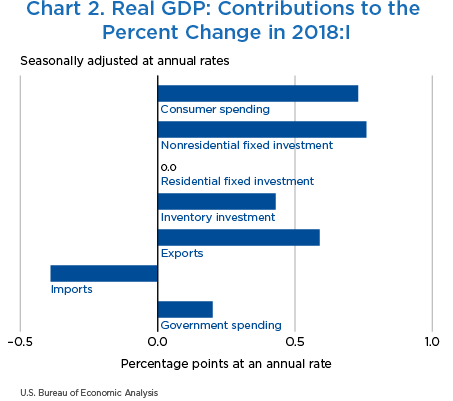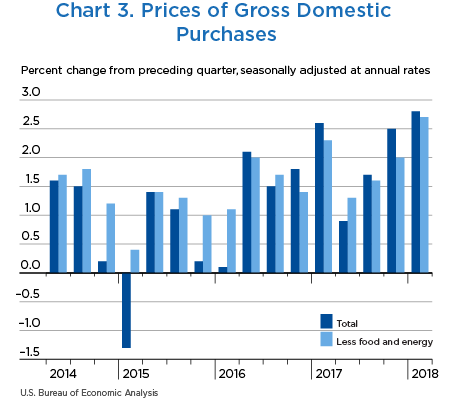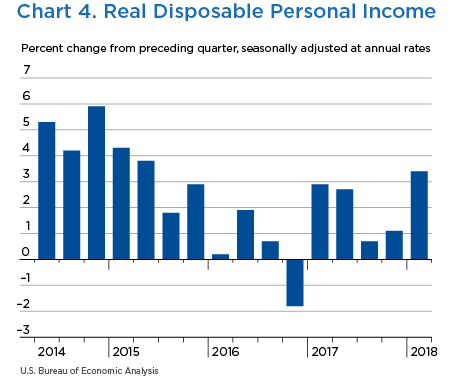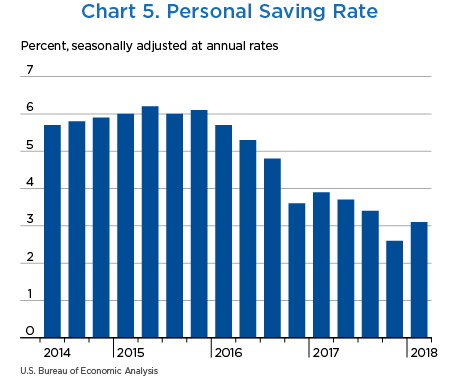GDP and the Economy
Advance Estimates for the First Quarter of 2018
Real gross domestic product (GDP) increased at an annual rate of 2.3 percent in the first quarter of 2018, according to the advance estimates of the National Income and Product Accounts (NIPAs) (chart 1 and table 1).1 In the fourth quarter, real GDP increased 2.9 percent.
The increase in real GDP in the first quarter reflected positive contributions from nonresidential fixed investment, consumer spending, exports, inventory investment, federal government spending, and state and local government spending (chart 2 and table 1).2 Imports, which are a subtraction in the calculation of GDP, increased.
Real GDP growth decelerated in the first quarter (table 1, line 1), reflecting decelerations in consumer spending, residential fixed investment, exports, and state and local government spending. These movements were partly offset by an upturn in private inventory investment. Imports, which are a subtraction in the calculation of GDP, decelerated.
- The deceleration in consumer spending (line 3) mainly reflected a downturn in spending for durable goods and a deceleration in spending for nondurable goods.
- The main contributor to the downturn in durable goods (line 4) was a downturn in motor vehicles and parts.
- The main contributors to the deceleration in nondurable goods (line 5) were a downturn in clothing and footwear and a deceleration in food and beverages purchased for off-premises consumption.
- The deceleration in residential fixed investment (line 13) reflected a downturn in “other” structures (mainly due to a downturn in brokers’ commissions and other ownership transfer costs and to a deceleration in improvements).
- The deceleration in exports (line 16) reflected a deceleration in exports of goods that was partly offset by an upturn in exports of services.
- The deceleration in exports of goods reflected downturns in industrial supplies and materials (mainly petroleum and products) and in “other” goods and a deceleration in nonautomotive capital goods. These movements were partly offset by an upturn in exports of foods, feeds, and beverages (mainly soybeans) and by an acceleration in automotive vehicles, engines, and parts.
- The upturn in exports of services mainly reflected upturns in travel and transport services.
- The deceleration in state and local government spending (line 26) reflected a downturn in investment in structures.
- The upturn in private inventory investment (line 14) mainly reflected an upturn in wholesale trade industries (for both durable and nondurable goods).
| Line | Share of current-dollar GDP (percent) | Change from preceding period (percent) | Contribution to percent change in real GDP (percentage points) | |||||||
|---|---|---|---|---|---|---|---|---|---|---|
| 2018 | 2017 | 2018 | 2017 | 2018 | ||||||
| I | II | III | IV | I | II | III | IV | I | ||
| 1 | Gross domestic product1 | 100.0 | 3.1 | 3.2 | 2.9 | 2.3 | 3.1 | 3.2 | 2.9 | 2.3 |
| 2 | Personal consumption expenditures | 69.0 | 3.3 | 2.2 | 4.0 | 1.1 | 2.24 | 1.49 | 2.75 | 0.73 |
| 3 | Goods | 22.1 | 5.4 | 4.5 | 7.8 | −1.1 | 1.16 | 0.97 | 1.67 | −0.24 |
| 4 | Durable goods | 7.5 | 7.6 | 8.6 | 13.7 | −3.3 | 0.56 | 0.63 | 0.98 | −0.25 |
| 5 | Nondurable goods | 14.6 | 4.2 | 2.3 | 4.8 | 0.1 | 0.61 | 0.34 | 0.69 | 0.01 |
| 6 | Services | 46.9 | 2.3 | 1.1 | 2.3 | 2.1 | 1.08 | 0.52 | 1.08 | 0.97 |
| 7 | Gross private domestic investment | 16.9 | 3.9 | 7.3 | 4.7 | 7.3 | 0.64 | 1.19 | 0.78 | 1.19 |
| 8 | Fixed investment | 16.7 | 3.2 | 2.4 | 8.2 | 4.6 | 0.53 | 0.40 | 1.31 | 0.76 |
| 9 | Nonresidential | 12.8 | 6.7 | 4.7 | 6.8 | 6.1 | 0.82 | 0.58 | 0.84 | 0.76 |
| 10 | Structures | 3.0 | 7.0 | −7.0 | 6.3 | 12.3 | 0.20 | −0.21 | 0.18 | 0.34 |
| 11 | Equipment | 5.8 | 8.8 | 10.8 | 11.6 | 4.7 | 0.48 | 0.58 | 0.63 | 0.27 |
| 12 | Intellectual property products | 4.1 | 3.7 | 5.2 | 0.8 | 3.6 | 0.15 | 0.21 | 0.03 | 0.14 |
| 13 | Residential | 3.9 | −7.3 | −4.7 | 12.8 | 0.0 | −0.30 | −0.18 | 0.46 | 0.00 |
| 14 | Change in private inventories | 0.2 | ...... | ...... | ...... | ...... | 0.12 | 0.79 | −0.53 | 0.43 |
| 15 | Net exports of goods and services | −3.2 | ...... | ...... | ...... | ...... | 0.21 | 0.36 | −1.16 | 0.20 |
| 16 | Exports | 12.4 | 3.5 | 2.1 | 7.0 | 4.8 | 0.42 | 0.25 | 0.83 | 0.59 |
| 17 | Goods | 8.3 | 2.2 | 1.8 | 11.6 | 6.1 | 0.18 | 0.15 | 0.89 | 0.49 |
| 18 | Services | 4.1 | 6.2 | 2.5 | −1.4 | 2.4 | 0.25 | 0.10 | −0.06 | 0.10 |
| 19 | Imports | 15.6 | 1.5 | −0.7 | 14.1 | 2.6 | −0.22 | 0.11 | −1.99 | −0.39 |
| 20 | Goods | 12.8 | 1.3 | −0.2 | 17.3 | 2.1 | −0.16 | 0.03 | −1.96 | −0.26 |
| 21 | Services | 2.8 | 2.2 | −2.6 | 1.1 | 4.8 | −0.06 | 0.07 | −0.03 | −0.13 |
| 22 | Government consumption expenditures and gross investment | 17.2 | −0.2 | 0.7 | 3.0 | 1.2 | −0.03 | 0.12 | 0.51 | 0.20 |
| 23 | Federal | 6.5 | 1.9 | 1.3 | 3.2 | 1.7 | 0.13 | 0.09 | 0.20 | 0.11 |
| 24 | National defense | 3.9 | 4.7 | 2.4 | 5.5 | 1.8 | 0.18 | 0.09 | 0.21 | 0.07 |
| 25 | Nondefense | 2.6 | −1.9 | −0.2 | −0.1 | 1.6 | −0.05 | −0.01 | 0.00 | 0.04 |
| 26 | State and local | 10.8 | −1.5 | 0.2 | 2.9 | 0.8 | −0.16 | 0.03 | 0.31 | 0.09 |
| Addenda: | ||||||||||
| 27 | Gross domestic income (GDI)2 | ...... | 2.3 | 2.4 | 0.9 | ...... | ...... | ...... | ...... | ...... |
| 28 | Average of GDP and GDI | ...... | 2.7 | 2.8 | 1.9 | ...... | ...... | ...... | ...... | ...... |
| 29 | Final sales of domestic product | 99.8 | 2.9 | 2.4 | 3.4 | 1.9 | 2.94 | 2.37 | 3.41 | 1.89 |
| 30 | Goods | 29.4 | 7.3 | 9.6 | 2.6 | 3.0 | 2.10 | 2.74 | 0.78 | 0.88 |
| 31 | Services | 62.3 | 2.1 | 1.5 | 1.9 | 1.8 | 1.32 | 0.93 | 1.18 | 1.10 |
| 32 | Structures | 8.3 | −4.3 | −6.2 | 12.2 | 4.1 | −0.36 | −0.51 | 0.93 | 0.34 |
| 33 | Motor vehicle output | 2.8 | 0.8 | −10.3 | 35.1 | 5.7 | 0.02 | −0.30 | 0.83 | 0.16 |
| 34 | GDP excluding motor vehicle output | 97.2 | 3.1 | 3.6 | 2.1 | 2.2 | 3.04 | 3.45 | 2.05 | 2.16 |
| 35 | Final sales of computers | 0.4 | 22.3 | −24.2 | 19.8 | 3.1 | 0.08 | −0.10 | 0.07 | 0.01 |
| 36 | GDP excluding final sales of computers | 99.6 | 3.0 | 3.3 | 2.8 | 2.3 | 2.98 | 3.26 | 2.82 | 2.31 |
| 37 | Research and development (R&D) | 2.5 | 1.3 | 0.9 | −0.4 | 2.9 | 0.03 | 0.02 | −0.01 | 0.07 |
| 38 | GDP excluding R&D | 97.5 | 3.1 | 3.2 | 3.0 | 2.3 | 3.03 | 3.13 | 2.90 | 2.25 |
- The GDP estimates under the contribution columns are also percent changes.
- GDI is deflated by the implicit price deflator for GDP.
Note. Percent changes are from NIPA tables 1.1.1 and 1.2.1, contributions are from NIPA tables 1.1.2 and 1.2.2, and shares are from NIPA table 1.1.10 or are calculated from NIPA table 1.2.5.
Prices for gross domestic purchases, goods and services purchased by U.S. residents, increased 2.8 percent in the first quarter of 2018 after increasing 2.5 percent in the fourth quarter of 2017 (table 2, line 1, and chart 3). The acceleration mainly reflected an acceleration in the prices paid for residential investment.
- The acceleration in prices paid for residential investment (line 13) reflected accelerations in new single-family construction and in brokers’ commissions and other ownership transfer costs.
- Consumer prices excluding food and energy (line 25), a measure of the “core” rate of inflation, accelerated, increasing 2.5 percent in the first quarter after increasing 1.9 percent in the fourth quarter.
| Line | Change from preceding period (percent) | Contribution to percent change in gross domestic purchases prices (percentage points) | |||||||
|---|---|---|---|---|---|---|---|---|---|
| 2017 | 2018 | 2017 | 2018 | ||||||
| II | III | IV | I | II | III | IV | I | ||
| 1 | Gross domestic purchases1 | 0.9 | 1.7 | 2.5 | 2.8 | 0.9 | 1.7 | 2.5 | 2.8 |
| 2 | Personal consumption expenditures | 0.3 | 1.5 | 2.7 | 2.7 | 0.18 | 1.02 | 1.83 | 1.82 |
| 3 | Goods | −3.6 | 0.7 | 1.8 | 2.0 | −0.79 | 0.16 | 0.38 | 0.43 |
| 4 | Durable goods | −3.6 | −2.5 | −2.1 | −1.6 | −0.27 | −0.19 | −0.15 | −0.12 |
| 5 | Nondurable goods | −3.6 | 2.4 | 3.8 | 3.9 | −0.52 | 0.34 | 0.53 | 0.55 |
| 6 | Services | 2.2 | 1.9 | 3.2 | 3.1 | 0.97 | 0.87 | 1.44 | 1.39 |
| 7 | Gross private domestic investment | 2.6 | 1.9 | 1.0 | 2.8 | 0.40 | 0.30 | 0.16 | 0.46 |
| 8 | Fixed investment | 2.5 | 1.9 | 1.0 | 2.9 | 0.40 | 0.30 | 0.16 | 0.47 |
| 9 | Nonresidential | 1.9 | 1.1 | 0.6 | 1.3 | 0.23 | 0.14 | 0.07 | 0.16 |
| 10 | Structures | 3.8 | 4.5 | 1.9 | 3.4 | 0.11 | 0.12 | 0.05 | 0.09 |
| 11 | Equipment | 0.8 | 0.2 | 0.2 | 0.2 | 0.04 | 0.01 | 0.01 | 0.01 |
| 12 | Intellectual property products | 1.9 | 0.1 | 0.0 | 1.3 | 0.08 | 0.00 | 0.00 | 0.05 |
| 13 | Residential | 4.6 | 4.4 | 2.5 | 8.5 | 0.17 | 0.16 | 0.09 | 0.31 |
| 14 | Change in private inventories | ...... | ...... | ...... | ...... | 0.01 | 0.00 | 0.00 | −0.01 |
| 15 | Government consumption expenditures and gross investment | 1.6 | 2.3 | 3.0 | 3.2 | 0.27 | 0.38 | 0.50 | 0.54 |
| 16 | Federal | 1.8 | 1.1 | 1.7 | 4.0 | 0.11 | 0.07 | 0.11 | 0.25 |
| 17 | National defense | 1.4 | 0.4 | 1.5 | 3.4 | 0.05 | 0.02 | 0.06 | 0.13 |
| 18 | Nondefense | 2.3 | 2.1 | 2.1 | 4.9 | 0.06 | 0.05 | 0.05 | 0.12 |
| 19 | State and local | 1.5 | 3.0 | 3.8 | 2.7 | 0.16 | 0.31 | 0.39 | 0.28 |
| Addenda: | |||||||||
| Gross domestic purchases: | |||||||||
| 20 | Food | 2.1 | 0.2 | 0.1 | 0.4 | 0.10 | 0.01 | 0.01 | 0.02 |
| 21 | Energy goods and services | −16.0 | 8.4 | 28.2 | 12.4 | −0.45 | 0.21 | 0.66 | 0.32 |
| 22 | Excluding food and energy | 1.3 | 1.6 | 2.0 | 2.7 | 1.21 | 1.49 | 1.82 | 2.48 |
| Personal consumption expenditures (PCE): | |||||||||
| 23 | Food and beverages purchased for off-premises consumption | 2.0 | 0.2 | 0.2 | 0.2 | ...... | ...... | ...... | ...... |
| 24 | Energy goods and services | −16.0 | 8.4 | 27.7 | 12.9 | ...... | ...... | ...... | ...... |
| 25 | Excluding food and energy | 0.9 | 1.3 | 1.9 | 2.5 | ...... | ...... | ...... | ...... |
| 26 | Gross domestic product (GDP) | 1.0 | 2.1 | 2.3 | 2.0 | ...... | ...... | ...... | ...... |
| 27 | Exports of goods and services | −0.1 | 3.3 | 5.8 | 3.9 | ...... | ...... | ...... | ...... |
| 28 | Imports of goods and services | −1.0 | 0.4 | 6.1 | 9.3 | ...... | ...... | ...... | ...... |
- The estimates under the contribution columns are also percent changes.
Note. Most percent changes are from NIPA table 1.6.7; percent changes for PCE for food and energy goods and services and for PCE excluding food and energy are from NIPA table 2.3.7. Contributions are from NIPA table 1.6.8. GDP, export, and import prices are from NIPA table 1.1.7.
Personal income (table 3, line 1), which is measured in current dollars, decelerated slightly in the first quarter, increasing $182.1 billion after increasing $186.4 billion in the fourth quarter. Decelerations in personal interest income (line 17), in rental income (line 15), and in nonfarm proprietors’ income (line 14) were mostly offset by accelerations in wages and salaries (line 3) and in government social benefits to persons (line 20).
- Personal current taxes (line 29) decreased $40.1 billion in the first quarter after increasing $50.1 billion in the fourth quarter.
- Disposable personal income (line 30) increased $222.1 billion in the first quarter; in the fourth quarter, it increased $136.3 billion.
- The personal saving rate (line 33)—personal saving as a percentage of disposable personal income—was 3.1 percent in the first quarter; in the fourth quarter, the saving rate was 2.6 percent.
- The accelerations in the first-quarter estimates of disposable personal income and the personal saving rate mostly result from the decrease in personal current taxes, which reflects the effects of the Tax Cuts and Jobs Act (TCJA). BEA estimates that the TCJA reduced personal current taxes by $115.5 billion at an annual rate (line 37). BEA’s preliminary estimates of the effects of the TCJA are partly based on projections prepared by the Treasury Department’s Office of Tax Analysis. For more information on the TCJA’s effects on personal taxes, see “How does the 2017 Tax Cuts and Jobs Act affect BEA’s estimates of personal taxes?”
- Wages and salaries in the first quarter were adjusted up by $10.0 billion (line 36) at an annualized rate to account for bonuses that are not included in the monthly source data in the Current Employment Statistics from the Bureau of Labor Statistics. This adjustment reflects one-time bonuses paid by businesses reported publicly in response to the TCJA and was derived based on news releases covering estimates of the number of employees who received bonuses and the payment amounts.
| Line | Level | Change from preceding period | |||||
|---|---|---|---|---|---|---|---|
| 2017 | 2018 | 2017 | 2018 | ||||
| IV | I | II | III | IV | I | ||
| 1 | Personal income | 16,655.3 | 16,837.4 | 94.3 | 129.4 | 186.4 | 182.1 |
| 2 | Compensation of employees | 10,463.3 | 10,596.3 | 76.7 | 113.1 | 107.2 | 133.0 |
| 3 | Wages and salaries | 8,485.2 | 8,601.5 | 63.1 | 97.4 | 92.6 | 116.4 |
| 4 | Private industries | 7,132.6 | 7,237.4 | 56.8 | 89.0 | 85.2 | 104.8 |
| 5 | Goods-producing industries | 1,391.8 | 1,423.5 | 9.3 | 16.6 | 15.3 | 31.8 |
| 6 | Manufacturing | 841.7 | 859.7 | 4.6 | 5.8 | 6.8 | 18.0 |
| 7 | Services-producing industries | 5,740.9 | 5,813.9 | 47.5 | 72.4 | 69.9 | 73.0 |
| 8 | Trade, transportation, and utilities | 1,322.7 | 1,335.5 | 7.1 | 12.2 | 14.9 | 12.7 |
| 9 | Other services-producing industries | 4,418.1 | 4,478.4 | 40.5 | 60.2 | 54.9 | 60.3 |
| 10 | Government | 1,352.5 | 1,364.2 | 6.3 | 8.4 | 7.4 | 11.6 |
| 11 | Supplements to wages and salaries | 1,978.1 | 1,994.8 | 13.6 | 15.7 | 14.6 | 16.6 |
| 12 | Proprietors' income with IVA and CCAdj | 1,403.1 | 1,419.2 | −1.6 | 3.3 | 21.2 | 16.1 |
| 13 | Farm | 29.6 | 27.9 | −4.8 | −5.1 | −2.4 | −1.6 |
| 14 | Nonfarm | 1,373.6 | 1,391.3 | 3.3 | 8.4 | 23.6 | 17.7 |
| 15 | Rental income of persons with CCAdj | 757.4 | 761.7 | 9.5 | 6.9 | 10.2 | 4.2 |
| 16 | Personal income receipts on assets | 2,481.1 | 2,504.0 | 14.4 | −0.6 | 47.2 | 22.9 |
| 17 | Personal interest income | 1,506.1 | 1,524.2 | −11.5 | −4.5 | 45.4 | 18.1 |
| 18 | Personal dividend income | 975.0 | 979.8 | 25.9 | 3.9 | 1.8 | 4.8 |
| 19 | Personal current transfer receipts | 2,873.2 | 2,910.6 | 5.1 | 21.4 | 14.9 | 37.3 |
| 20 | Government social benefits to persons | 2,812.6 | 2,848.9 | 4.3 | 20.7 | 14.1 | 36.4 |
| 21 | Social security | 935.4 | 961.0 | 6.8 | 7.2 | 5.4 | 25.6 |
| 22 | Medicare | 681.9 | 685.8 | 4.1 | 4.9 | 5.5 | 3.9 |
| 23 | Medicaid | 590.8 | 599.6 | −4.0 | 6.0 | 7.5 | 8.7 |
| 24 | Unemployment insurance | 27.8 | 27.5 | −1.7 | −0.1 | −0.7 | −0.3 |
| 25 | Veterans' benefits | 100.2 | 103.3 | 2.5 | 1.2 | 0.9 | 3.2 |
| 26 | Other | 476.4 | 471.8 | −3.4 | 1.6 | −4.5 | −4.7 |
| 27 | Other current transfer receipts, from business (net) | 60.7 | 61.6 | 0.7 | 0.7 | 0.8 | 1.0 |
| 28 | Less: Contributions for government social insurance | 1,322.8 | 1,354.4 | 9.7 | 14.7 | 14.4 | 31.6 |
| 29 | Less: Personal current taxes | 2,108.2 | 2,068.1 | −10.9 | 50.2 | 50.1 | −40.1 |
| 30 | Equals: Disposable personal income (DPI) | 14,547.1 | 14,769.2 | 105.2 | 79.2 | 136.3 | 222.1 |
| 31 | Less: Personal outlays | 14,167.3 | 14,307.1 | 134.1 | 121.2 | 240.1 | 139.8 |
| 32 | Equals: Personal saving | 379.8 | 462.1 | −28.9 | −42.1 | −103.8 | 82.3 |
| 33 | Personal saving as a percentage of DPI | 2.6 | 3.1 | ...... | ...... | ...... | ...... |
| Addenda: | |||||||
| Percent change at annual rate | |||||||
| 34 | Current-dollar DPI | ...... | ...... | 3.0 | 2.2 | 3.8 | 6.2 |
| 35 | Real DPI, chained (2009) dollars | ...... | ...... | 2.7 | 0.7 | 1.1 | 3.4 |
| The effects of special factors on changes in DPI | |||||||
| In wages and salaries, private industries: | |||||||
| 36 | One-time bonuses paid in response to the Tax Cut and Jobs Act (TCJA) | ...... | ...... | 0.0 | 0.0 | 0.0 | 10.0 |
| In personal current taxes: | |||||||
| 37 | Effect of the TCJA | ...... | ...... | 0.0 | 0.0 | 0.0 | −115.5 |
- CCAdj
- Capital consumption adjustment
- IVA
- Inventory valuation adjustment
Note. Dollar levels and percent changes are from NIPA tables 2.1 and 2.2B.
- “Real” estimates are in chained (2009) dollars, and price indexes are chain-type measures. Each GDP estimate for a quarter (advance, second, and third) incorporates increasingly comprehensive and improved source data; for more information, see “The Revisions to GDP, GDI, and Their Major Components” in the January 2018 Survey of Current Business. Quarterly estimates are expressed at seasonally adjusted annual rates, which reflect a rate of activity for a quarter as if it were maintained for a year.
- In this article, “consumer spending” refers to “personal consumption expenditures,” “inventory investment” refers to “change in private inventories,” and “government spending” refers to “government consumption expenditures and gross investment.”




